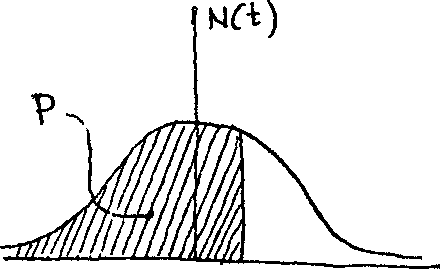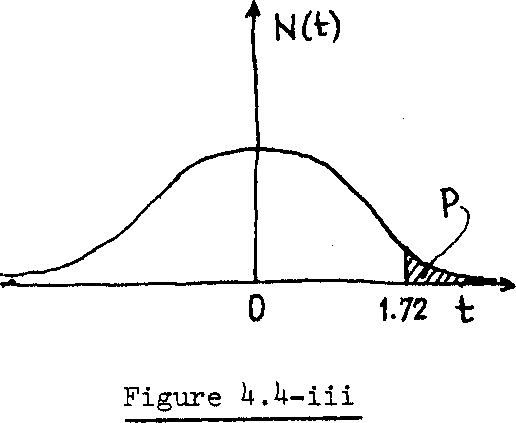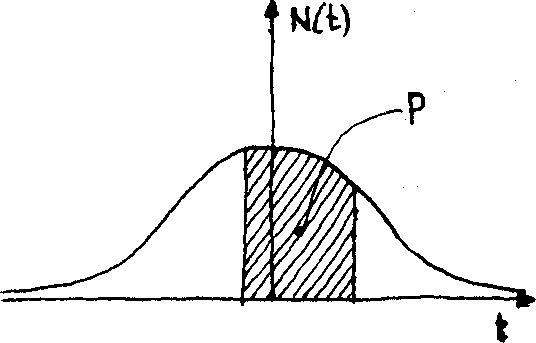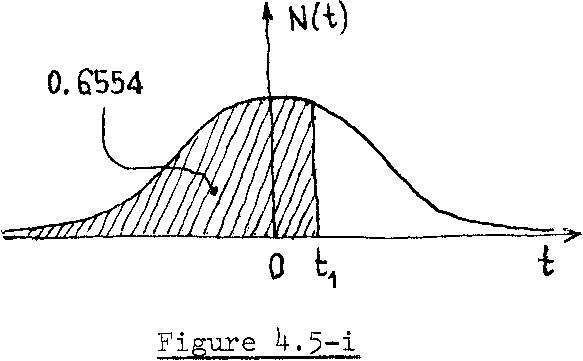
- •Introduction to adjustment calculus
- •Introduction to adjustment calculus (Third Corrected Edition)
- •Introduction
- •2. Fundamentals of the mathematical theory of probability
- •If d'cd; then p (d1) £ lf
- •Is called the mean (average) of the actual sample. We can show that m equals also to:
- •3.1.4 Variance of a Sample
- •Is called the variance (dispersion) the actual sample. The square root 2
- •In the interval [6,10] is nine. This number
- •VVII?I 0-0878'
- •In this case, the new histogram of the sample £ is shown in Figure 3.5.
- •Is usually called the r-th moment of the pdf (random variable); more precisely; the r-th moment of the pdf about zero. On the other hand, the r-th central moment of the pdf is given by:
- •3.2.4 Basic Postulate (Hypothesis) of Statistics, Testing
- •3.3.4 Covariance and Variance-Covariance Matrix
- •X and X of a multivariate X as
- •It is not difficult to see that the variance-covariance matrix can also be written in terms of the mathematical expectation as follows:
- •3.3.6 Mean and Variance-Covariance Matrix of a Multisample The mean of a multisample (3.48) is defined as
- •4.2 Random (Accidental) Errors
- •It should be noted that the term иrandom error" is used rather freely in practice.
- •In order to be able to use the tables of the standard normal
- •X, we first have to standardize X, I.E. To transform X to t using
- •Is a normally distributed random
- •4.10 Other Measures of Dispersion
- •The average or mean error a of the sample l is defined as
- •5. Least-squares principle
- •5.2 The Sample Mean as "The Maximum Probability Estimator"
- •5.4 Least-Sqaures Principle for Random Multivariate
- •In very much the same way as we postulated
- •The relationship between e and e for a mathematical model
- •6.4.4 Variance Covariance Matrix of the Mean of a Multisample
- •Itself and can be interpreted as a measure of confidence we have in the correctness of the mean £. Evidently, our confidence increases with the number of observations.
- •6.4.6 Parametric Adjustment
- •In this section, we are going to deal with the adjustment of the linear model (6.67), I.E.
- •It can be easily linearized by Taylor's series expansion, I.E.
- •In which we neglect the higher order terms. Putting ax for X-X , al for
- •The system of normal equations (6.76) has a solution X
- •In sections 6.4.2 and 6.4.3. In this case, the observation equations will be
- •In matrix form we can write
- •In metres.
- •6.4.7 Variance-Covariance Matrix of the Parametric Adjustment Solution Vector, Variance Factor and Weight Coefficient Matrix
- •I.E. We know the relative variances and covariances of the observations only. This means that we have to work with the weight matrix к£- 1
- •If we develop the quadratic form V pv 3) considering the observations l to be influenced by random errors only, we get an estimate к for the assumed factor к given by
- •Variance factor к plays. It can be regarded as the variance of unit
- •In metres,
- •Is satisfied. This can be verified by writing
- •Into a . О
- •6.U.10 Conditional Adjustment
- •In this section we are going to deal with the adjustment of the linear model (6.68), I.E.
- •For the adjustment, the above model is reformulated as:
- •Is not as straightforward, as it is in the parametric case (section 6.4.6)
- •VeRn VeRn
- •Into the above vector we get 0.0
- •0.0 In metres .
- •In metres.
- •Areas under the standard normal curve from 0 to t
- •Van der Waerden, b.L., 1969: Mathematical Statistics, Springer-Verlag.
In order to be able to use the tables of the standard normal
PDF and CDF for computations concerning a given normal random variable
X, we first have to standardize X, I.E. To transform X to t using
equation (^-13), then enter these tables with t. Thus, if we want,
for instance, to determine the probability P(x £ x ) we have to write:
x-y x -y
P(x < xQ) = l-V^ ) . (^-19)
X X
This is identical to the probability P(t £ t ) that can be obtained from the standard normal tables.


0 04
Figure k.k - i
Suppose that the height h of a student
Is a normally distributed random
variable with mean y, = 66 inches and
h
standard deviation cr, = 5 inches. Find
h
the approximate number К out of 1000 students h inches tall: (i) h £ 68 inches (Figure U.U-i) * (ii) h £ 6l inches (Figure k.h^ii)}
*
In
most of the computer languages, this error function, erf (t) is a
built-in function. Hence, it can be called as any library
subroutine and
evaluated
more precisely than using the corresponding tables.
-1.0
о
Figure
b.U-ii
-0.34
0 0.8
Figure
iv

|
1 |
|
|
IS A M |
|
|
|
(iv) [6k.3 <. h <_ 70] inches (Figure U.U-iv), Solution: We are going to use the Table in Appendix II-B.
(i) P(h < 68) = P(t )
= P(t <. 0.U0) = 0.655*1 .
-t ' Hence, K± = (0.655*0(1000) = 655 students, (ii) P(h 1 61) - P(t <_ii=66 }

= P(t 1 -1) = 1-P(t <_ 1)
=
1.
-
0.8U13
=
0.1587
.
Hence,
K2
=
(0.1587)(lOOO)
=
159
students
.
(iii)
P(h
>
7b.6)
=
P(t
>
T^6-66
)
= P(t >_ 1.72)
= 1. - P(t <_ 1.72)
= 1. - 0.9573 = 0pU27 .
Hence, K_ = (0.0^27)(1000) = U3 students.
(iv) P(6U.3 1 h <_ 70) =
, p
(бЬ.3-66
<
t
<12=бб
}
p
(бЬ.3-66
<
t
<12=бб
}
= P (-0.3k < t < 0.80) = P(t £ 0.80) - P(t <. -0.3^)
= p(t 1 0.80) - (l-p(t <. 0.3k) = 0.7881 - [1-0.6331] = 0.7881 - 0.3669 = 0Д212 ,
Hence Кц = (0.U212)(1000) = U21 students.


For the normal random variable h given in example 4.2, determine the studentf s height H such that: (i) P(h <, H ) = 0.6554 (Figure U.5-i) ;
(ii) P (h >, H2) = 0.25 (Figure U-5-ii); (iii) P (h £ H ) = 0.20 (Figure 4-5-iii);
(iv) P(H4£ h<H ) = 0.95,
where = y^-K and = y^+K. (Figure 4,5-iv) Solution: Again in this example, we are going to use the standard normal CDF table given in Appendix II-B. (i) P(h ± H ) = P(t ± t±) = 0.655^ . From the above mentioned table, we get t = 0.4, that corresponds to probability P = 0.6554. But we know
H1-uh
that tn = — •
1 ah
From example 4-2 we have y^ = 66 inches
and = 5 inches. Hence, V-66
*1 = 5 " =
from which we get
H - 66 = 5(0.4) = 2,
i.e.
H^ = 66 + 2 = 68 inches, which is identical to the first case in example 4.2; however;what we are doing here is nothing else but the inverse solution.
юз
(ii) P(h >. H ) = P(t >. t ) - 0.25. But:
P(t >_ t2)= 1-P (t £ t2) = 0.25, and we get
P(t <_ t ) .= 1 - 0.25 = 0.75. By interpolation in the above mentioned table we get \, = 0.675 which corresponds to P = 0.75* Hence,
i.e. H2 =66+5 (0.675)
= 66 + 3.375 = 69.375 inches .
(iii) P(h £ H3) = P(t £ t3) = 0.20 • By examining the above mentioned table we discover that the smallest probabil- ity reading is 0. 50, since it considers only the positive values of t, Therefore we have to write:
P(t 1 t3) = 1 - P(t <r*3) = 0.20,
and we get
P(t <?t^) = 1 - 0.20 = 0.80.
By interpolation in the above mentioned
table we get: (-t3) = 0.81+2, which
corresponds to P = 0.80. Then we have: H -66
t = — - -0.8U2
and, H0 = 66-5(0.8U2)
3 5
l3
= 66-U,210 =,6l.79 inches.
(iv) Р(Н^ <h£H5)
= p(_A_ii < t < \
= < t < ^- )
= р(-*0 <t£t ) = 0.95:
where t = — = — о ah 5
The above statement means that:
p(t 1 *0) - p("t 1г*0) = 0.95.
However, from the symmetry of the. normal PDF we get:
p(t
>
to)
=
P(t
<.-tQ)
=
1>
"
= 0.
and we get:
P(t £ t ) = 0.95 + 0.025 = 0.975, or P(t <_ t ) = 1. - 0.025 = 0.975. From the above mentioned table we get: t = I.965 which corresponds to P = 0.975э and we have: tQ-f-1.96,
i.e. К = 5(1.96) = 9.80. Consequently H^ = |ih-K = 66-9*B0 = 56.2 inches and
H5 = yh+K = 66 + 9.80 = 75.8 Inches.
can
write:
P(-a
<
e
<
a
)
= P(
|
|
|
||
|
|
|||
|
i |
i |
|
|
Let us solve example 4.1 again by using the standard normal CDF tables. Recall that it was required to comput P(~a < e < a ), where e has a Gaussian PDF (i.e. its у = 0). We
-a -y . a -y
£ — — £
a ~*0 , a
£ ■ ■ < t <
£ £ <t < £
0
= P(
- — a
£ £
= P(-l £ t £ l) , see Figure 4.6.
Further we can write:
p(-1 <t < 1) = 2P(0 £ t £ 1).
From the table given in Appendix II-C
we get:
P(0 < t < 1) = 0.3413-Hence 5
P(-aP < £ < a ) = 2(0.3413)
= 0.6826 = 0.683, which is the same result as obtained in example 4.1.
U•T Basic Hypothesis (Postulate) of the Theory of Errors,
Testing
We have left the random sample of observations L behind in section k.2 while we developed the analytic formulae for the PDF*s mostly used in the error theory. Let us get back to it and state the following basic postulate of the error-theory. A finite sequence of observations L representing the same physical quantity is declared a random sample with parent random variable distributed according to the normal PDF Ж(у^э cr^; a). Other PDFT s are used rather seldom. The validity of this hypothesis may or may not be tested, on which topic we shall not elaborate here.
The mean of the sample L is said to approximate (the word estimate is often used in this context) the mean у of the parent PDF,
JO
2
i. e. N(y^3 a ^; Z). Also, the variance of the sample L is said to estimate the variance a| of the parent PDF.
Considering the original sample
L = u ) = u'+e ) , i = 1, 2, .. . , n,
we get:
n
ML
- Y, £. = - /z, (£'+£.) = - (nA1) + - e . = ' A1 + M . (U-20) ni=l 1 n 1=1 in n 1=1 1 e
Since the random errors eT s are postulated to have a parent Gaussian PDF N(05 a£; e )> which implies that = 0, then we should expect that M 0 and we can write equation (U-20) as:
e
ML = = y£ 9 (U-21)
ют
keeping in mind that Ъу the unknown value l} we mean the unknown mean
у of the parent PDF of I.
We say that the mean M of the sample L-
approximates (estimates) the value of the mean y^ of the parent PDF of £. Similarly5 we get
2
1
Sf
=
-
Л L
n i=
l, (A.-JL Г = 1 .I1U.-(A,+ M )] г = i lie. - M ) - S .=1 l V n 1=1 i e m--i=l 1 £ c
The above result indicates that the variance S^ of the sample L is
2
identical to the variance S^ of its corresponding sample of random errors
2
£. This is actually why S is sometimes called the mean square error of
-Li ' ' '
the sample, and is abbreviated by MSE. Also, SL is known as the root mean square error of the sample , and is abbreviated by RMS, According to the basic hypothesis of the error-theory we can write equation (4-22) as :
![]()
(b-23)
which states that ST estimates the variance о of the parent PDF of
П

![]()
Assume that the sample L = (2, 75 6, 4,
2,7, 4, 85 6, 4) is postulated to be
normally distributed. Let us transform
this sample in such a way that the transformed
sample will have:
(i) Gaussian distribution '»
(ii) Standard normal distribution.
Solution: First we compute the mean
2
and the variance S of the given sample as follows:
i 10 i
MT e io ill £i=Io-(50) = 5'
According to the basic postulate of the error-theory we can say that:
= ^ = 5 and V a£ = SL = 2,
where у ^ and c^ are respectively the mean and the standard deviation of the parent normal PDF N (у , ; l) assumed for the given sample. The parameters
у ^ and о^ will be used for the required transformations as follows:
(i) The Gaussian distribution G(c£; e), where G£ ~ a£ = 2 э has an argument e obtained from equation (^-10) as:
V^^r^' i - 2, ...,io.
Hence the transformed sample that has a Gaussian PDF is:
z = (e^, i = 1, 2, ... , 10 i.e.
- (-3, 2, 1, -19 -3, 2, -1, 3, 1, -1).
(ii) The standard normal distribution N(t), has an argument t obtained from equation (4-13) as:
*i e~^s V-'1 -x'2 io-
Hence, the transformed sample that has
a standard normal PDF is T = (t^)5
i = 1, 2, . . . , 10 5 i.e.:
T = (-1.5, 1, 0.5, -0.5, -1.5, 1, -0.5,
1.5, 0.5, -0.5).
4.8 Residuals, Corrections and Discrepencies
As we have seen, we are not able to compute the unknown value I 'or y^. All we can get is an estimate 1 for it from the following equation
b^^'+M^ £f+ e, *) (4-24)
and hope that e , in accordinace with the basic postulate of the error-theory, will really go to zero.
The residual r. is defined as the difference between the :— i
*
From
now on, we shall use the symbol
I
for
the mean of the sample L. The "bar"
above
the symbol will indicate the sample mean to make the notation
simpler.
(it.25)
Residuals with inverted signs are usually called corrections. It should be noted that a residual, as defined above, is a uniquely determined value and not a variable. The observed value SL is fixed and so is the mean £ for the particular sample. In other words, for a given sample, the residuals can be computed in one way only. Note that the differences (£_^ - £) = r^ are called residuals and not errors, because errors are defined as = (£^- y^) and y^ may be different from £.
In practice, one often hears talks about "minimized residuals", "variable residuals" etc. which are not strictly correct. If one wants to regard the "residuals as variables" the problem has to be stated differently. The difference v^ between the observed value £^ and any arbitrarily assumed (or computed) value £°, i.e.
v.
=
£. - £°,
i =
1,
2,
.
. ., n
l
l
(U.26)
should be called discrepency, or misclosure, to distinguish it from the . residual. These discrepencies are obviously linear functions of £°jtheir values vary with the choice of £°. Hence one can talk about "minimization of discrepencies", "variation of discrepencies" etc. Evidently, residuals and discrepencies are very often mixed up in practice.
At this point it is worthwhile to mention yet another pair of
2
formulae for computing the sample mean £ and the sample variance S . Such
L
simplified formulae facilitate the computations especially for large samples
Ill
whose elements have large numerical values. The development of these formulae is done analogically to the formulation of equations (4.20), (4.22), (4.25) and (4.26). Here we state only the results, and the elaboration is left to the student.
C.2T)
I = £° + v ,
and
l=l
where: 1° is an arbitrarily cj^sen value, usually close to I;
- 1 n
v = j Z v. , (4.29)
i=l
v.= £. - £° l l
and
r± = l± - I = vi - v. (4.30)
Example 4.6: The second column of the following table is a sample of 10
observations of the same distance. It is required to compute
the sample mean and variance using the simplified formulae given in this section.
We take £° = 972.0 m,
1 10 1
v = ~q 'I v± = (10.50) = 1.05 m,
i=l
X s lo + у = 972.0 + 1.05 = 973.05 m,
MSE = Sl = lo 1 ri2 s 10 fo •5730) = °'0513' m2 i=l
and RMS = SL = 0.24 m.
n
One of the checks on the computations is that Z r. = 0,
i=l 1
see the fourth column of the given table.
Г""1 No. |
|
; ■ ■ .v = Q _ 0° |
r =1.-1 |
r.2 . 1014' (m ) |
|
(m) |
1 1 (m) |
l 1 = V. - V 1 |
|
1 |
972.89 |
0.89 |
-0.16 |
256 |
2 |
973.1+6 |
1.1*6 |
0Л1 |
1681 |
3 |
973.ok |
1.0k |
-0.01 |
1 |
k |
972.73 |
0.73 |
-О.32 |
1021+ |
5 |
972.63 |
0.63 |
-0.1+2 |
176b |
6 |
973.01 |
1.01 |
-0.0k |
16 |
7 |
973.22 |
1.22 |
0.17 |
289 |
8 |
973.10 |
1.10 |
0.05 |
, 25 |
9 |
, 973.30 |
1.30 |
0.25 |
625 |
10 |
973.12 |
1.12 |
0.07 |
1+9 |
|
\ -i 1 |
10.50 * , .... _ |
-0.95 +0.95 = 0.00 |
5730 |
h.9 Other Possibilities Eegarding the Postulated PDF
The normal PDF (or its relatives) are by no means the only bell-shaped PDF1s that can be postulated. Under different assumptions, one can derive a whole multitude of bell-shaped curves. Generally, they would contain more than two parameters which is an advantage from the point of view of fitting them to any experimental PDF. In other words the additional parameters provide more flexibility. On the other hand, the computations
-with such PDF's are more troublesome. In this context let us just mention that some recent attempts have been made to design a family of PDF1 s that are more peaked than the normal PDF in the middle. Such PDFfs are called "Leptokurtic"• This more pronounced peakedness is a feature that quite a few scholars claim to have spotted in the majority of observational samples. We shall have to wait for any definite word in this domain for some time.
Hence, the normal is still the most popular PDF and likely to remain so because it is relatively simple and contains the least possible number of parameters - the mean and the standard deviation.
